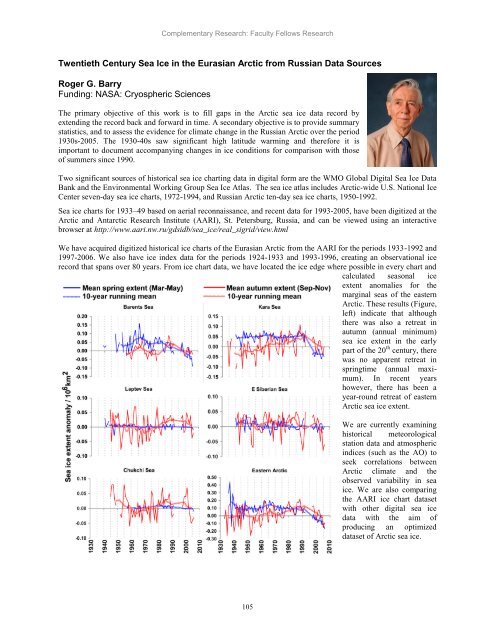Scientific Theme: Advanced Modeling and Observing Systems
Scientific Theme: Advanced Modeling and Observing Systems
Scientific Theme: Advanced Modeling and Observing Systems
Create successful ePaper yourself
Turn your PDF publications into a flip-book with our unique Google optimized e-Paper software.
Complementary Research: Faculty Fellows Research<br />
Twentieth Century Sea Ice in the Eurasian Arctic from Russian Data Sources<br />
Roger G. Barry<br />
Funding: NASA: Cryospheric Sciences<br />
The primary objective of this work is to fill gaps in the Arctic sea ice data record by<br />
extending the record back <strong>and</strong> forward in time. A secondary objective is to provide summary<br />
statistics, <strong>and</strong> to assess the evidence for climate change in the Russian Arctic over the period<br />
1930s-2005. The 1930-40s saw significant high latitude warming <strong>and</strong> therefore it is<br />
important to document accompanying changes in ice conditions for comparison with those<br />
of summers since 1990.<br />
Two significant sources of historical sea ice charting data in digital form are the WMO Global Digital Sea Ice Data<br />
Bank <strong>and</strong> the Environmental Working Group Sea Ice Atlas. The sea ice atlas includes Arctic-wide U.S. National Ice<br />
Center seven-day sea ice charts, 1972-1994, <strong>and</strong> Russian Arctic ten-day sea ice charts, 1950-1992.<br />
Sea ice charts for 1933–49 based on aerial reconnaissance, <strong>and</strong> recent data for 1993-2005, have been digitized at the<br />
Arctic <strong>and</strong> Antarctic Research Institute (AARI), St. Petersburg, Russia, <strong>and</strong> can be viewed using an interactive<br />
browser at http://www.aari.nw.ru/gdsidb/sea_ice/real_sigrid/view.html<br />
We have acquired digitized historical ice charts of the Eurasian Arctic from the AARI for the periods 1933-1992 <strong>and</strong><br />
1997-2006. We also have ice index data for the periods 1924-1933 <strong>and</strong> 1993-1996, creating an observational ice<br />
record that spans over 80 years. From ice chart data, we have located the ice edge where possible in every chart <strong>and</strong><br />
calculated seasonal ice<br />
extent anomalies for the<br />
marginal seas of the eastern<br />
Arctic. These results (Figure,<br />
left) indicate that although<br />
there was also a retreat in<br />
autumn (annual minimum)<br />
sea ice extent in the early<br />
part of the 20 th century, there<br />
was no apparent retreat in<br />
springtime (annual maximum).<br />
In recent years<br />
however, there has been a<br />
year-round retreat of eastern<br />
Arctic sea ice extent.<br />
105<br />
We are currently examining<br />
historical meteorological<br />
station data <strong>and</strong> atmospheric<br />
indices (such as the AO) to<br />
seek correlations between<br />
Arctic climate <strong>and</strong> the<br />
observed variability in sea<br />
ice. We are also comparing<br />
the AARI ice chart dataset<br />
with other digital sea ice<br />
data with the aim of<br />
producing an optimized<br />
dataset of Arctic sea ice.
















